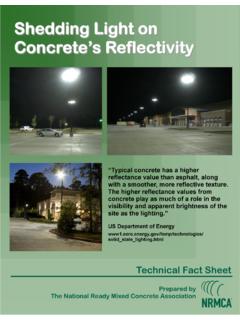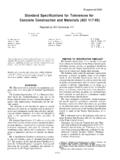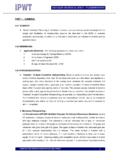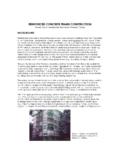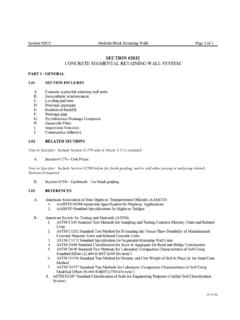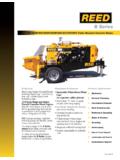Transcription of Concrete Parking Lot Design & Construction …
1 FAQ. Concrete Parking Lot Design & Construction Specifications The intent of this document is to address, through When should dowels be incorporated? references to industry publications and expertise, ACI 330 R-08 Experience has shown that dowels common Design questions and issues that arise or other load-transfer devices are not needed for during the course of designing and constructing most Parking lot In thinner pavements Concrete Parking lots. of 7 in. and less, round dowels can be impractical or counterproductive. Usually, it is more economical Reinforcement to keep joint space close, using aggregate interlock, We've always used Welded Wire Mesh (WWM) and and thicken the pavement slightly, if necessary to you are telling us not to.
2 What gives? Welded wire reduce deflections.. mesh provides no increase in pavement structural capacity as some mistakenly believe. The job of Jointing WWM is to keep cracks tight that may form from Why is jointing so important? Beyond aesthetics, environmental or traffic loading stresses. To keep jointing has many purposes including improving cracks tight, the mesh has to be put in the correct long-term durability. Some of the best Concrete place, which is rarely done. Below are references Parking lots have been achieved with proper citing more explanations: jointing patterns, completed at the correct time 1.
3 ACI 330R-08 When pavement is jointed to of placement with proper tools and without form short panel lengths that will minimize secondary reinforcement. Jointing details are intermediate cracking, distributed steel often over-looked and can lead to pavement reinforcing is not necessary. The practice of performance issues if not designed and detailed adding distributed steel to increase panel correctly. In fact, NRMCA believes proper jointing lengths has largely been discredited, and is so important that it created a program called generally leads to excessive joint movements the Design Assistance Program to aid engineers in and interior panel cracks that deteriorate over Concrete Parking lot Design and jointing at no cost time.
4 To the engineer. References and other educational 2. ACPA ( ) ( related to jointing may be found in: org/ ) If the pavement 1. ACI 330R-08 (Section ). is jointed to form relatively short panels that 2. NRMCA Concrete In Practice (CIP) Series #4. will control cracking, distribute steel is not and #6. necessary. This Design is called plain or non- 3. NRMCA Jointing Webinar reinforced Concrete . For light traffic situations, 4. ACPA Intersection Joint Layout ISOO6P. load transfer is provided by aggregate interlock 5. ACPA Design and Construction of Joints for the roughness of the cracked faces beneath Concrete Streets ISOO061P.
5 The joint. 6. ACPA Concrete Pavements with Undoweled Joints for Light Traffic Facilities ISOO405P. Expansion Joints We've always put expansion joints every 25- 50 feet to prevent unwanted cracking, what has changed? There are three types of joints: Construction , contraction and isolation joints. Construction joints are for the purpose of providing an interface between placements done at two different times. Contraction joints predetermine crack locations associated with hydration and curing of Concrete . For contraction and Construction joints, the maximum joint spacing regardless of thickness is 15 feet according to American Concrete Institute documents.
6 The FHWA states that good Design and maintenance of contraction (sawcut) and Construction joints have virtually eliminated the need for expansion joints, except at fixed objects such as structures. In these situations isolation joints, which are similar in nature to expansion joints, are now used to separate Concrete from fixed objects to accommodate for horizontal and vertical movement. In particular, isolation joints are used when Concrete pavements meet structures. And, wood strips are not a good idea in any type of Concrete joint because they restrain the natural movement of the Concrete from changing environmental conditions.
7 1. ACI 330R-08 (Section ) Isolation joints are not recommended for routine use as regularly spaced joints. They are difficult to construct and maintain, provide no load transfer, and can be a source of pavement distress, distortion, and premature failure.. 2. ACPA Proper Use of Isolation and Expansion Joints in Concrete Pavements. 3. ACI Joints in Concrete Construction . Chapter 6. Subbase We have terrible soil conditions, how can you say we don't need a subbase under Concrete ? Every job is addressed differently depending on the local conditions and application.
8 Some soils can offer great support for Concrete Parking lots and can actually perform better than imported aggregates. Many Concrete Parking lots have been completed with no base and are performing well years later. Other Parking lots need additional base due to the conditions of the project. Often light-duty and heavy-duty pavement sections are differentiated the percentage of heavy vehicles is unusually on the plans and can be addressed accordingly. high. Pumping is not a problem unless there are 1. ACI 330R-08 (Section ) It is not economical large numbers of heavy wheel loads and the to use subbase material for the sole purpose pavement foundation is wet.
9 Of increasing k-values granular subbases are 6. Design of Subgrades and Bases Under not normally used for Concrete Parking lots and Concrete Pavements in Low Volume should not be used as a Construction expedient Pavement Applications instead of proper subgrade Normally, pavements that carry less than 200. heavily loaded trucks/day will not be damaged Joint sealing by pumping, especially if speeds are low; What about joint sealing? We always ask owners therefore, they do not require subbases. if they plan to maintain the joint sealants.
10 If the 2. ACI R-02 Experience suggests that for answer is no, the owner is better off keeping the pavements that fall into residential classification joint spacing small. Recent studies from Texas (22 kip SAL, 34 kip TAL) the use of a subbase A& to increase structural capacity may or may 1. Design of Subgrades and Bases Under not be cost effective in terms of long term Concrete Pavements in Low Volume performance of the With adequate Pavement Applications subgrade preparation and appropriate considerations for surface and subgrade 2.
